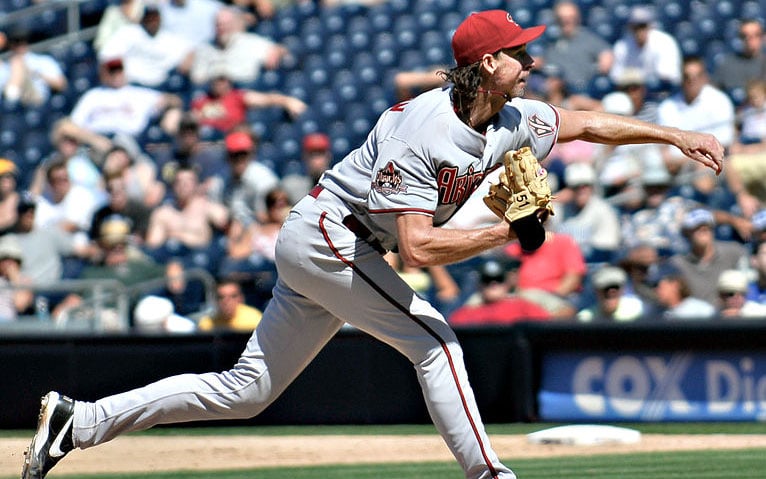
Former Diamondbacks pitcher Randy Johnson struggled with his command early in his career, but he eventually became an intimidating force that earned him a ticket to the Hall of Fame. (Photo via Creative Commons/Flickr)
Some pitchers in baseball are described as graceful.
Others might be labeled crafty.
But for former Arizona Diamondbacks pitcher Randy Johnson, who will be inducted into the National Baseball Hall of Fame on Sunday, one word comes up more than most: intimidating.
At 6 feet 10 inches tall, Johnson’s towering career spanned 22 years of power pitching in six different cities, testing batters’ resolve and, the majority of the time, dominating those batters.
But Johnson’s aggressive style didn’t come without its complications, as the lefty faced control issues early on in his professional baseball life.
See related story:
En route to Hall, Johnson continues to be a valuable resource for D-backs
“I don’t know if (hitters) were intimidated. I think they were more scared just because I couldn’t throw strikes and I don’t think anybody ever wants to get hit,” Johnson said. “I think they were more fearful of that, getting hit, than facing me.”
Johnson hit 190 batters throughout his career, leading the league in batters hit with 18 and 16 in 1992 and 1993, respectively.
In addition to Johnson, Sunday’s Hall of Fame class includes Johnson’s one-time teammate, Craig Biggio, and fellow pitchers Pedro Martinez and John Smoltz.
Smoltz, a 21-year major leaguer, said it took time for Johnson to mold his game into something great.
“He didn’t know where the ball was going for most of that minor league upbringing getting to the big leagues,” Smoltz said. “He learned how to fine-tune his mechanics. He learned how to throw one of the nastiest sliders.”
Johnson eventually improved his control, finishing his career with 1,497 walks.
“Initially, I think there was a fear that they just didn’t want to get hit,” Johnson said. “And then over time I think hitters probably saw some development and the ability to throw more strikes and the development of me to be able to throw more over time.”
Biggio played with Johnson during Johnson’s two-month stint in Houston in 1998. Johnson went an impressive 10-1 for the Astros, leading the team to an appearance in the National League Divisional Series against the San Diego Padres.
“Early on in his career he’d walk a lot of guys, but that’s not the guy that I saw,” Biggio said. “The guy that I saw knew exactly what he wanted to do and he threw hard and it was a lot of fun to play behind.”
Johnson spent 18 of his 22 major league years in Seattle and Phoenix, winning four of his five Cy Young Awards and a World Series while in Arizona, but he said it was his time in Houston with Biggio that marked his greatest playing stretch ever.
“When I went to Houston, it was the best two months of my career,” Johnson said of his time with the Astros.
Johnson’s numbers in Houston were stunning. Over 11 starts, he struck out 133 batters and posted a 1.37 ERA in 98 1/3 innings,
“I remember (Jeff Bagwell) and I, after the trade happened, how pumped up and excited we were,” Biggio said. “Randy was the piece to the puzzle to get us to the World Series.”
While the Astros did not make it to the World Series that year, instead losing to the Padres in the NLDS, Biggio believes it was worth it.
“I’d do that trade in a heartbeat again for Randy because we had a chance to go to the World Series,” Biggio said of the deal that brought Johnson to the Astros from Seattle in exchange for pitchers Freddy Garcia and John Halama and shortstop Carlos Guillen. “It just never worked out.”
Johnson’s imposing demeanor would became a trademark of his game, following him throughout his career.
“What I love about Randy was he was a power pitcher,” Biggio said. “You watch the competitiveness that he had on the days that he pitched, I loved it. He was a bulldog and it rubbed off on the rest of the pitching staff.”
As Johnson is immortalized within the National Baseball Hall of Fame Sunday, the pitcher’s career will always be synonymous with hard-throwing, high-velocity baseball.
“He had the ability to stand on the mound and be absolutely intimidating,” Smoltz said. “I’m glad I never had to face him.”